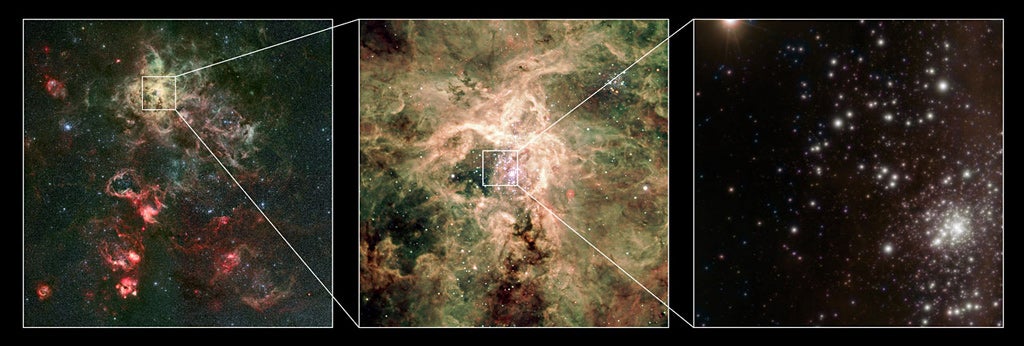Stars are thought to form in interstellar space from dark clouds of gas and dust. Their properties are expected to depend on the conditions of their dusty birth environment in the same way that the temperature and constitution of clouds on Earth determine whether we experience drizzly weather, rain with large or small droplets, or a hail shower. In contrast, until now, stars have appeared to unexpectedly form in the same manner everywhere. “Sites of star formation are the bad weather regions in a galaxy, and the forming stars are, in a very rough analogy, like the raindrops condensing out of this material,” said Pavel Kroupa from the University of Bonn.
The group of scientists now has evidence that the mass distribution of stars does, indeed, depend on the environment in which they form. “Surprisingly, this evidence does not come to us from young regions of ongoing star formation but from a very old class of objects, so-called globular star clusters,” said Michael Marks from the University of Bonn. “The number of observed stars less massive than our Sun in globular clusters is at odds with their structure.”
Globular clusters are massive congregations of thousands of stars surrounding our galaxy, the Milky Way. Star formation in these clusters ceased billions of years ago. “Nevertheless, using our simulations, we found that the connection between star formation and birth environment can be understood when invoking a process that occurs very early in the life of any cluster, called residual-gas expulsion,” said Marks.
Once a star completes its formation, it starts to shine, and eventually the radiation coming from the cluster of freshly hatched stars quickly drives out the gas from which they formed. The region of star birth is then destroyed, leaving behind stars of different masses. “This process leads to expansion of the whole aggregate of stars with the accompanying stripping of some of the stars from the cluster by the gravitational attraction of the young Milky Way,” said Kroupa. “The faster the gas is blown out, the stronger is the expansion and the more stars are removed. The imprint of this process is still visible in the present-day mass distribution.” This means that careful observations of present-day stellar populations in globular clusters allow their initial star content to be reconstructed.
The astronomers found that globular clusters must have formed with many more massive stars than are counted in individual star-forming regions today. “Otherwise, the star birth region a globular cluster formed from is not destroyed quickly enough, and the subsequent expansion is too weak to remove enough stars from the cluster,” said Marks. “If this had happened, the distribution of masses of stars we see today would be quite different.” The deduced differences in the number of massive stars having formed in globular clusters depending on the cloud conditions is indeed in agreement with theoretical expectation.
According to their results, differences in the initial star content appear only when conditions in the star birth regions are extreme compared to those we see today. “We do not observe these extreme environments in the present day, but these may have well been frequent when globular clusters were born around 12 billion years ago,” Marks said. Their work predicts that stars form in the same way, with the same range of masses, in different sites in the present-day Milky Way.
“With this work, we might have uncovered the long-expected systematic differences in the star formation process,” said Kroupa. The Bonn astronomers now plan to use further simulations to study the effect of these differences on the long-term evolution of globular star clusters.










